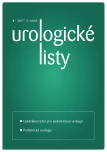Obstructive uropathy in infancy
Authors:
MUDr. Oldřich Šmakal, Ph.D.
Authors‘ workplace:
Urologická klinika LF UP a FN Olomouc
Published in:
Urol List 2007; 5(1): 16-21
Overview
Progress in ultrasound examination techniques in the 1980's applied to the uropoetic system in children increased dramatically the efficiency of detection for asymptomatic dilatations of the pyelocaliceal system (PCS). Children with PCS dilatation were examined and in most cases operated on a very timely basis. Monitoring the natural development of the kidney affected by PCS dilatation in the 1990's showed that the functional capacity of the kidney does not decrease even if conservative therapy was applied. Over the last 10 years, diagnostics and treatment of obstructive uropathies in children have improved dramatically and new morphological, functional and laboratory examining methods have been introduced. In spite of that, there is still the issue of timely detection of prognostically significant drainage disorder causing kidney function impairment.
Key words:
infant age, obstructive uropathy, diagnostics, treatment
Sources
1. Amarante J, Anderson PJ, Gordon I. Impaired drainage on diuretic renography using half-time or pelvic excretion efficiency is not a sign of obstruction in children with a prenatal diagnosis of unilateral renal pelvic dilatation. J Urol 2003; 169(5): 1828-1831.
2. Beetz R, Bokenkam A, Brandis M et al (APN-Konsensusgruppe). Diagnostik bei konnatalen Dilatationen der Harnwege. Urol 2001; 40 : 495-509.
3. Dillon HK. Prenatally diagnosed hydronephrosis: the Great Ormond Street experience. Br J Urol 1998; Suppl 2 : 39-44.
4. Dinneen MD, Duffy PG. Posterior urethral valves. BJU 1996; 78 : 275-281.
5. Eddy AA. Molecular basis of renal fibrosis. Pediatr Nephrol 2000; 15 : 291-301.
6. English PJ, Testa HJ, Lawson RS et al. Modified method of diuresis renography for the assesment of equivocal pelviureteric obstruction. Br J Urol 1987; 59 : 10-14.
7. Fernbach S, Maizels M, Conway JJ. Ultrasound grading of hydronephrosis: introduction to the system used by Society for Fetal Urology. Pediatr Radiol 1993; 23 : 478-480.
8. Grahame H, Smith H, Douglas A at al. The long-term outcome of posterior urethral valves treated with primary valve ablation and observation. J Urol 1996; 155 : 1730-1734.
9. Greenfield P. Editorial: posterior urethral valves-new concepts. J Urol 1997; 157 : 996-997.
10. Guidelines EAU 2001. http://www.uroweb.nl/files/ uploaded_files/2001_PAEDIATRIC_UROLOGY.PDF
11. Guidelines EAU 2006. http://www.uroweb.nl/ files/uploaded_files/guidelines/19%20Paediatric%20Urology.pdf
12. Hafez AT, Mc Lorie G, Bägli D, Khoury A. Analysis of trends on serial ultrasound for high grade neonatal hydronephrosis. J Urol 2002; 168 : 1518-1521.
13. Holmdahl G, Sillén U, Bachelard E et al. The changing urodynamic pattern in valve bladders during infancy. J Urol 1995; 153 : 463-465.
14. Chevalier RL. Biomarkers of congenital obstructive nephropathy: past, present and future. J Urol 2005; 173 : 2207-2208.
15. Kaneto H, Morrissey J, Klahr S. Increased expression of TGF-ß1 mRNA in the obstructed kidney of rats with unilateral ureteral ligation. Kidney Int 1993; 44 : 313-321.
16. Keating MA, Escala J, Snyder HM et al. Changing concepts in management of primary obstructive megaureter. J Urol 1989; 142 : 636-640.
17. Kočvara R. Vrozené vady dolních močových cest. In: Dvořáček J et al. Urologie. Praha: ISV 1998 : 573-599.
18. Koff SA, Cambell KD. The nonoperative management of unilateral neonatal hydronephrosis: Natural history of poorly functioning kidneys. J Urol 1994; 152 : 593-595.
19. Koff SA, Keller PA. Diagnostic criteria for assessing obstruction in the newborn with unilateral hydronephrosis using the renal growth-renal function chart. J Urol 1995; 154 : 662-666.
20. Koff SA. Neonatal management of unilateral hydronephrosis. Role for delayed intervention. Urol Clin of North Am 1998; 25 : 181-186.
21. Perez-Brayfield MR, Kirsch AJ, Jones RA. A prospective study comparing ultrasound, nuclear scintigraphy and dynamic contrast enhanced magnetic resonance imaging in the evaluation of hydronephrosis. J Urol 2003; 170 : 1330-1334.
22. Peters CA, Mandell J, Lebowitz RL et al. Congenital obstructed megaureters in early infancy: diagnosis and treatment. J Urol 1989; 142 : 641-645.
23. Salam M. Posterior urethral valve: Outcome of antenatal intervention. Int J Urol 2006; 13 : 1317-1322.
24. Shokeir AA, Nijman RJ. Ureterocele: an ongoing challenge in infancy and childhood. BJU Int 2002; 90 : 777-783.
25. Shokeir AA, Nijman RJ. Primary megaureter: current trends in diagnosis and treatment. BJU Int 2000; 86 : 861-868.
26. Smith GH, Ducket JW. Urethral Lesions in Infants and Children. In: Gillenwater JY, Grayhack JT, Howards SS, Duckett JW (eds). Adult and Pediatric Urology. 3. ed. Philadelphia: Mosby 1996 : 2411-2443.
27. Steiner D, Steiss JO, Klett R et al. The value of renal scitigraphy during controlled diuresis in children with hydronephrosis. Eur J Nucl Med 1999; 26 : 18-21.
28. Thomas DF. Prenatally detected uropathy: epidemiological considerations. Br J Urol 1998; 81(suppl 2): 8-12.
29. Tripp BM, Homsy YL. Neonatal hydronephrosis the controvesy and the management. Pediatr Nephrol 1995; 9 : 503-509.
30. Woodward M, Frank D. Postnatal mangement of antenatal hydronephrosis. BJU Int 2002; 89 : 149-156.
Labels
Paediatric urologist UrologyArticle was published in
Urological Journal

2007 Issue 1
Most read in this issue
- Hypospadias - optimum methods of treatment
- Varicocele - what is the best timing and method of treatment?
- Sexual diferentiation disorders
- Obstructive uropathy in infancy
